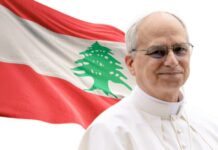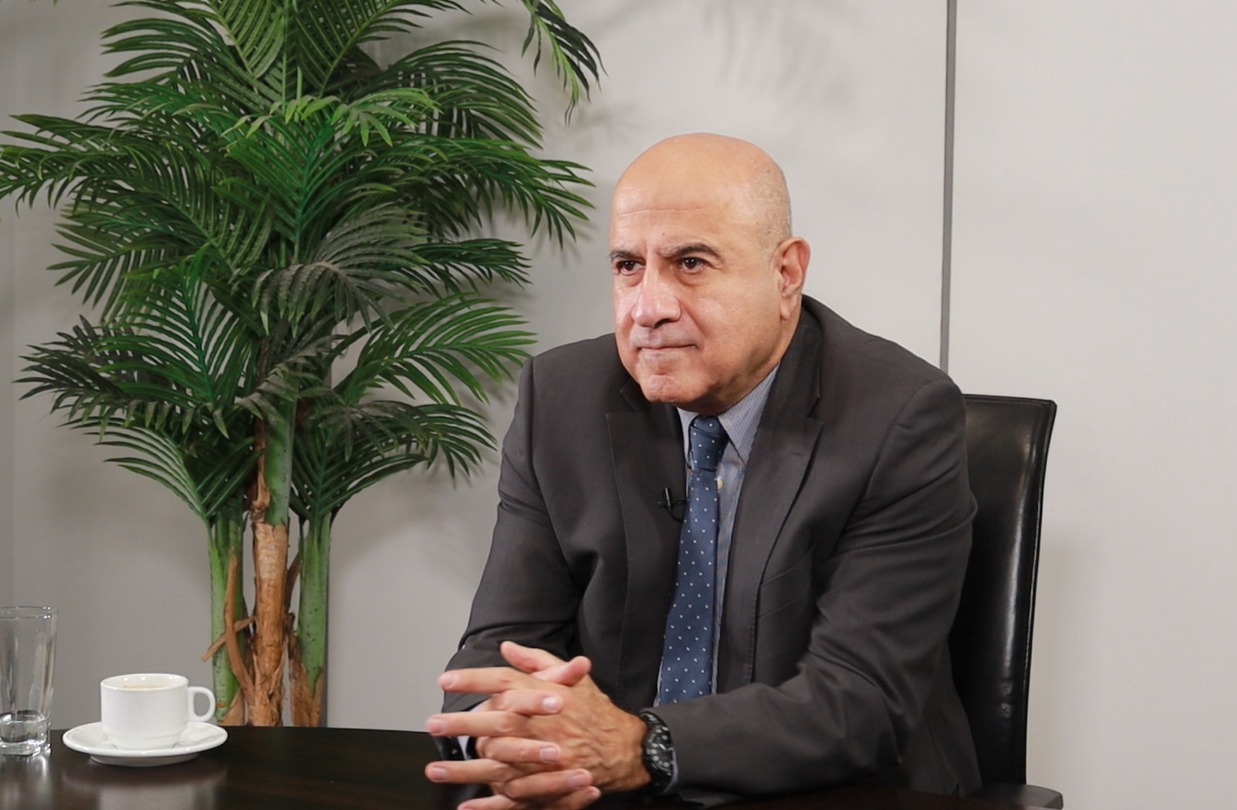مقالة للسفير البيرتو م. فرنادندس تتناول الصراع بين نظام الحكم في جمهورية أرمينيا والكنيسة الأرمنية
حرب االإخوة: الكنيسة الأرمنية تحت وطأة النظام الأرمني
السفير ألبيرتو م. فرنانديز/نقلا عن موقع ميمري/24 تشرين الثاني/2025 |
(ترجمة بحرية من الإنكليزية بواسطة الياس بجاني)
The Armenian Church At The Hands Of The Armenian Regime
Amb. Alberto M. Fernandez/MEMRI Daily Brief No. 869/November 24/2025 |
To say that there is a connection between the Armenian Apostolic Church and Armenian identity and nationalism would be an understatement. The identity of this ancient Anatolian people for thousands of years was reforged when Armenia became the first Christian nation in 301 A.D. The Armenian Church – one of the four “Oriental Orthodox” Churches – was the repository of much of Armenian identity, especially during the many centuries that this people were under foreign rule – Persian, Arab, Turkish, or Russian.[1]
Given such a deep connection, it is more than a bit shocking that the Armenian Church is suffering an ongoing wave of arrests and accusations – personal, partisan, and political – at the hands of the government of the Republic of Armenia. Prime Minister Nikol Pashinyan has not only arrested priests, bishops, and archbishops, he, his wife, and political party have engaged in a harsh war of words with the Head of the Armenian Church itself, Catholicos Karekin II.[2] The roots of this clash between the prime minister and the Church go back years.
Coming to power in the democratic Velvet Revolution of 2018 against corrupt and autocratic rule, the journalist and politician Pashinyan was styled a pro-Western reformer, a product of Western investment in Eastern European civil society in the wake of the collapse of the Soviet Union. Russian propaganda says that Pashinyan and his circle are the product of the likes of the Soros Foundation and organizations like USAID and NED. Anti-Russian voices counter that the 2018 revolt was the will of the Armenian people (later ratified in democratic elections won overwhelmingly by Pashinyan).[3] Both sides are telling the truth.
Pashinyan rose to power railing against the so-called “Karabakh Clan,” former politicians who came originally from the Armenian enclave in Azerbaijan and who had risen to high office in Armenia.[4] And yet it was Pashinyan himself who in 2019 would controversially utter the unprecedented statement that “Karabakh is a part of Armenia and full stop!”[5]
As political scientist Kimataka Matsuzato has convincingly argued, it was Pashinyan, more than any other individual, who is responsible for the loss of Karabakh because of a series of disastrous political, diplomatic, and military decisions made by his government.[6] This is a key part of the dispute with the Church.
The Armenian Church has criticized Pashinyan’s governance, on Karabakh and other matters, and the Prime Minister is aggressively seeking to shore up his political position before elections slated to be held in June 2026. He has broad powers of coercion and repression, ironically inherited by him from the autocrat Prime Minister Sargsyan who was overthrown in 2018. Pashinyan has used them ruthlessly against church leaders.[7]
On June 25, 2025, the Armenian government arrested Archbishop Bagrat Galstanyan and 13 others, charging them with treason and terrorism in plotting a supposed coup. The charismatic Galstanyan led popular demonstrations against Pashinyan for his Karabakh policies and for handing four border villages in Armenia proper (in his diocese of Tavush) to Azerbaijan.[8] The Prime Minister described the arrests as disrupting a “large and sinister plan by the criminal-oligarchic clergy to take power.”[9] Archbishop Galstanyan’s trial is still ongoing.[10]
On June 27, 2025, the government took into custody Archbishop Mikayel Ajapahyan (they had earlier tried to arrest on the grounds of Etchmiadzin Cathedral and had been prevented by the people). Charged with attempting to overthrow the government, Ajapahyan was sentenced in September to two years in prison.[11]
On October 15, 2025, six more priests, including Bishop Mkrtich Proshyan, who is the nephew of Catholicos Karekin II, were arrested and charged with “coercing” people to attend anti-government demonstrations in 2021, demonstrations against the government’s policies on Nagorno-Karabakh.[12]
Looming over the arrests and serving as the backdrop to the campaign against the Church is the August 8, 2025 Armenia-Azerbaijan Peace Deal, an agreement engineered by the Trump Administration which, among other things, aimed at preventing an invasion by Azerbaijan of Armenia.[13] Azerbaijan is still gearing up for war in terms of weapons purchases and bellicose rhetoric but is also holding out carrots as well as sticks. On November 14, 2025, for the first time in 30 years, a grain shipment arrived in Armenia from Kazakhstan having crossed Azerbaijan.[14] Part of the promise of the peace deal is that it would bring not just peace but prosperity (and enhanced regional trade) to Armenia.[15]
In a difficult balancing act, Pashinyan seeks to blame his critics within the Church of being pro-Russian (even though Galstanyan is Western-educated) and of trying to overthrow him while knowing that attacking the Church is generally unpopular and hoping that the deal will improve things quickly enough to matter for ordinary citizens. Meanwhile he faces hostile propaganda from Russia and Iran and principled criticism from Armenians (in and outside the Church) while he tries to blur the difference between the two.[16]
There seems little doubt that the political campaign against the Armenian Church is politically motivated, much of the evidence and charges are trumped up, and that it could turn out quite badly for all Armenians.[17] Pashinyan may not even be thinking just of his own political future but may believe that suffocating opposition is the only way to preserve Armenia in the face of invasion.[18] As one Azeri outlet approvingly noted, “the Church stands in the way” of Pashinyan’s vision.[19] One day soon we will know whether cynicism or self-sacrifice, or a weird combination of both, was the main factor in this campaign. And whether it was actually worth it.
*Alberto M. Fernandez is Vice President of MEMRI.
مقالة للسفير البيرتو م. فرنادندس تتناول الصراع بين نظام الحكم في جمهورية أرمينيا والكنيسة الأرمنية
حرب االإخوة: الكنيسة الأرمنية تحت وطأة النظام الأرمني
السفير ألبيرتو م. فرنانديز/نقلا عن موقع ميمري/24 تشرين الثاني/2025 |
(ترجمة بحرية من الإنكليزية بواسطة الياس بجاني)
القول بأن هناك صلة بين الكنيسة الرسولية الأرمنية والهوية والقومية الأرمنية سيكون بمثابة تبسيط. فقد تم صقل هوية هذا الشعب الأناضولي العريق على مدى آلاف السنين عندما أصبحت أرمينيا أول دولة مسيحية في عام 301 بعد الميلاد. وكانت الكنيسة الأرمنية – وهي إحدى الكنائس “الأرثوذكسية الشرقية” الأربع – مستودعاً لجزء كبير من الهوية الأرمنية، خاصة خلال القرون العديدة التي كان فيها هذا الشعب تحت الحكم الأجنبي – سواء الفارسي أو العربي أو التركي أو الروسي.[1]
بالنظر إلى هذا الارتباط العميق، فمن الصادم إلى حد ما أن الكنيسة الأرمنية تعاني من موجة مستمرة من الاعتقالات والاتهامات – الشخصية والحزبية والسياسية – على يد حكومة جمهورية أرمينيا. فلم يكتفِ رئيس الوزراء نيكول باشينيان باعتقال القساوسة والأساقفة ورؤساء الأساقفة، بل انخرط هو وزوجته وحزبه السياسي في حرب كلامية قاسية مع رأس الكنيسة الأرمنية نفسه، الكاثوليكوس كاريكين الثاني.[2] وتعود جذور هذا الصدام بين رئيس الوزراء والكنيسة إلى سنوات مضت.
بعد وصوله إلى السلطة في الثورة المخملية الديمقراطية عام 2018 ضد الحكم الفاسد والاستبدادي، وُصف الصحفي والسياسي باشينيان بأنه مصلح مؤيد للغرب، ونتاج للاستثمار الغربي في المجتمع المدني بأوروبا الشرقية في أعقاب انهيار الاتحاد السوفيتي. تقول الدعاية الروسية إن باشينيان ودائرته هم نتاج مؤسسات مثل مؤسسة سوروس ومنظمات مثل الوكالة الأمريكية للتنمية الدولية (USAID) والوقف الوطني للديمقراطية (NED). في المقابل، يرى الأصوات المناهضة لروسيا أن ثورة 2018 كانت إرادة الشعب الأرمني (تم التصديق عليها لاحقًا في انتخابات ديمقراطية فاز بها باشينيان بأغلبية ساحقة).[3] كلا الجانبين يقول الحقيقة.
صعد باشينيان إلى السلطة مهاجماً ما يسمى بـ “عشيرة قرة باغ”، وهم سياسيون سابقون ينحدرون أصلاً من الجيب الأرمني في أذربيجان والذين وصلوا إلى مناصب عليا في أرمينيا.[4] ومع ذلك، كان باشينيان نفسه هو الذي أدلى في عام 2019 بالتصريح المثير للجدل وغير المسبوق بأن “قرة باغ جزء من أرمينيا ونقطة على السطر!”[5]
وكما زعم عالم السياسة كيماتاكا ماتسوزاتو بشكل مقنع، فإن باشينيان، أكثر من أي فرد آخر، مسؤول عن خسارة قرة باغ بسبب سلسلة من القرارات السياسية والدبلوماسية والعسكرية الكارثية التي اتخذتها حكومته.[6] وهذا جزء أساسي من النزاع مع الكنيسة.
لقد انتقدت الكنيسة الأرمنية حكم باشينيان، بشأن قرة باغ ومسائل أخرى، ويسعى رئيس الوزراء بقوة لتعزيز موقعه السياسي قبل الانتخابات المقرر إجراؤها في يونيو 2026. وهو يتمتع بسلطات واسعة للإكراه والقمع، ورثها له، ومن المفارقات، من رئيس الوزراء المستبد سركسيان الذي أطيح به في عام 2018. وقد استخدمها باشينيان بلا هوادة ضد قادة الكنيسة.[7]
في 25 يونيو 2025، اعتقلت الحكومة الأرمنية رئيس الأساقفة باغرات غالستانيان و13 آخرين، ووجهت إليهم تهمة الخيانة والإرهاب في التخطيط لانقلاب مزعوم. قاد غالستانيان الكاريزماتي مظاهرات شعبية ضد باشينيان بسبب سياساته في قرة باغ ولتسليمه أربع قرى حدودية داخل أرمينيا نفسها (في أبرشيته تافوش) إلى أذربيجان.[8] ووصف رئيس الوزراء الاعتقالات بأنها إحباط لـ “خطة كبيرة وشريرة من قبل رجال الدين الإجراميين والأوليغارشيين للاستيلاء على السلطة”.[9] ولا تزال محاكمة رئيس الأساقفة غالستانيان مستمرة.[10]
في 27 يونيو 2025، احتجزت الحكومة رئيس الأساقفة ميكائيل أجاباهيان (وكانوا قد حاولوا اعتقاله سابقاً في حرم كاتدرائية إتشميادزين ومنعهم الناس من ذلك). حُكم على أجاباهيان بالسجن لمدة عامين في سبتمبر بعد اتهامه بمحاولة الإطاحة بالحكومة.[11]
في 15 أكتوبر 2025، تم اعتقال ستة قساوسة آخرين، بمن فيهم المطران مكرتيتش بروشيان، وهو ابن شقيق الكاثوليكوس كاريكين الثاني، بتهمة “إجبار” الناس على حضور مظاهرات مناهضة للحكومة في عام 2021، وهي مظاهرات ضد سياسات الحكومة بشأن ناغورني قرة باغ.[12]
ويُلقي اتفاق السلام بين أرمينيا وأذربيجان في 8 أغسطس 2025 بظلاله على الاعتقالات، ويكون بمثابة خلفية للحملة ضد الكنيسة. هذا الاتفاق الذي هندسته إدارة ترامب، والذي يهدف، من بين أمور أخرى، إلى منع غزو أذربيجان لأرمينيا.[13] لا تزال أذربيجان تستعد للحرب من حيث شراء الأسلحة والخطاب العدواني، ولكنها تقدم أيضاً الجزر (المكافآت) بقدر ما تقدم العصي (العقوبات). ففي 14 نوفمبر 2025، وصلت شحنة حبوب إلى أرمينيا من كازاخستان، عبرت أذربيجان، لأول مرة منذ 30 عاماً.[14] جزء من الوعد الذي يحمله اتفاق السلام هو أنه لن يجلب السلام فحسب، بل سيجلب أيضاً الازدهار (وتعزيز التجارة الإقليمية) لأرمينيا.[15]
في عملية موازنة صعبة، يسعى باشينيان إلى اتهام منتقديه داخل الكنيسة بأنهم موالون لروسيا (على الرغم من أن غالستانيان متعلم في الغرب) وبمحاولة الإطاحة به، وهو يعلم أن مهاجمة الكنيسة لا يحظى بشعبية بشكل عام ويأمل في أن يؤدي الاتفاق إلى تحسين الأوضاع بسرعة كافية لتكون ذات أهمية للمواطنين العاديين. في غضون ذلك، يواجه دعاية معادية من روسيا وإيران وانتقادات مبدئية من الأرمن (داخل الكنيسة وخارجها) بينما يحاول طمس الفارق بين الاثنين.[16]
يبدو أن هناك شكاً ضئيلاً في أن الحملة السياسية ضد الكنيسة الأرمنية ذات دوافع سياسية، وأن الكثير من الأدلة والتهم ملفقة، وأنها قد تنتهي بشكل سيئ للغاية بالنسبة لجميع الأرمن.[17] قد لا يفكر باشينيان في مستقبله السياسي فحسب، بل قد يعتقد أن خنق المعارضة هو السبيل الوحيد للحفاظ على أرمينيا في مواجهة الغزو.[18] وكما أشارت إحدى وسائل الإعلام الأذربيجانية بالموافقة، فإن “الكنيسة تقف في طريق” رؤية باشينيان.[19] قريباً سنعرف ما إذا كانت السخرية أو التضحية بالنفس، أو مزيج غريب منهما، هو العامل الرئيسي في هذه الحملة. وما إذا كانت تستحق العناء فعلاً.
*ألبيرتو م. فرنانديز هو نائب رئيس معهد بحوث إعلام الشرق الأوسط (MEMRI).
[1] Armenianpress.com/the-crucial-role-of-the-armenian-apostolic-church-preserving-heritage-and-shaping-identity, June 18, 2024.
[2] Aljazeera.com/news/2025/7/8/in-armenia-a-bitter-dispute-escalates-between-pm-pashinyan-and-the-church, July 8, 2025.
[3] Euvsdisinfo.eu/report/armenias-pm-nikol-pashinyan-came-to-power-with-support-from-soros, January 9, 2023.
[4] Azernews.az/region/150946.html, May 20, 2019.
[5] Top-center.org/en/analytics/3515/the-evolution-of-armenian-discourse-on-karabakh, May 29, 2023.
[6] Kimataka Matsuzato, “The Velvet Revolution, the Russo-Ukrainian War, and the End of Karabakh: Armenian Politics Causing Its Own Catastrophe,” The Soviet and Post Soviet Review (2025)
[7] Firstthings.com/the-meaning-of-armenias-prayer-breakfast, November 18, 2025.
[8] Armenianweekly.com/2024/05/08/tavush-for-the-homeland-movement-headed-to-yerevan-protesting-land-concessions, May 8, 2024.
[9] Theweek.in/news/world/2025/06/25/why-has-armenia-arrested-prominent-archbishop-bagrat-galstanyan-cleric-s-lawyer-describes-charges-as-fiction.html, June 25, 2025.
[10] Panarmenian.net/eng/news/327994, November 11, 2025.
[11] Oc-media.org/yerevan-court-finds-armenian-archbishop-ajapahyan-guilty-of-publicly-calling-for-a-coup, September 25, 2025.
[12] Reuters.com/world/six-priests-detained-armenia-investigation-into-church-figures-widens-2025-10-15, October 15, 2025.
[13] Politico.com/news/2025/08/08/trump-peacemaker-azerbaijan-armenia-00501073, August 8, 2025.
[14] Balcanicaucaso.org/en/cp_article/armenia-and-azerbaijan-edge-closer-to-peace, November 14, 2025.
[15] Thehill.com/homenews/administration/5442862-trump-armenia-azerbaijan-peace-deal, August 8, 2025.
[16] Msn.com/en-us/news/world/armenia-faces-an-information-war-on-three-fronts-opinion/ar-AA1Qrcxn?ocid=BingNewsSerp, November 14, 2025.
[17] Csi-int.org/news/religious-freedom-advocates-urge-armenia-to-end-attacks-on-church, July 17, 2025.
[18] Christiantoday.com/news/evangelicals-offer-praise-for-armenia-pm-after-he-recites-bible-at-prayer-breakfast-amid-church-tensions, November 17, 2025.
[19] Azernews.az/analysis/250369.html, November 17, 2025.






















